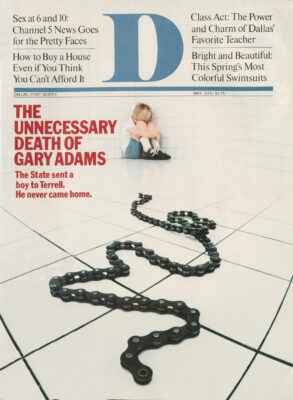Akin vs. Dahl
It has been my opinion that there isn’t one newspaper reporter or writer in ten thousand who can report a public trial, civil or criminal, correctly, and present it to the public in a manner that is pleasant, interesting, and will make delightful reading.
Convey to David Bauer my congratulations on his “Akin vs. Dahl” (April). I know most of the parties and from Mr. Bauer’s description of the courtroom scene, 1 had the feeling that I had been there. Many thanks.
Earle B. Mayfield Jr.
Attorney At Law
Little Elm, Texas
Country Matters
Just read Larry Sons’ article on memorable words from country music songs (“I Don’t Know Whether to Kill Myself or Go Bowling,” March). Right there on just four pages are all the words one would ever want to know from country music.
Wrong, honky-tonk breath, you say? Well actually, a few of my favorites were missing. Like:
“What made Milwaukee famous made a loser out of me.”
“When I go down Main Street, should I turn left and go right, or should I turn right and go wrong?”
“Watch where the huskies go, and don’t eat none of that yellow snow.”
“Living here, and loving there, and lying in between.”
“Wasn’t God who made honky-tonk angels.”
Now, how about a contest to name the songs and authors of some of those classics?
Rusty EubanksFort Worth
A Peril of Great Price
We read with interest Tom Peeler’s “String of Perils” (March). Mr. Peeler makes a few informative statements about homeowners’ policies; however, it appears he did not take his own advice and “read every blessed word.” A few of the more obvious errors:
1. Mr. Peeler states that “if you loseyour $2000 Rolex in Lake Texoma whilewrestling a striper, the standard Form Cpays, while the standard Form Bdoesn’t.” In fact, even under Form C,losses of this nature are subject to the$500-per-occurrence limitation on jewelry.
2. Mr. Peeler states that the standardHomeowners Form B has a limit of $1000on property away from the insuredpremises. The policy actually states thatthe limit is $1000 or 10 percent of theamount of coverage on personal property, whichever is greater.
3. In Mr. Peeler’s discussion regardingthe Replacement Cost Coverage provisionof the policy, his example using the$10,000 loss and $5000 under insurancepenalty is misleading. The policy statesthat “In no event shall the Company’sliability be less than its liability under theterms and conditions of this policy,disregarding this replacement costcoverage.” In other words, the Insuredmay elect to settle his loss on an actualcash value (replacement cost lessdepreciation) basis. Since the house used in Mr. Peeler’s example was purchased “a few years ago,” it is hardly conceivable that the house would be subject to 50 percent depreciation in case of a partial loss.
4. Mr. Peeler states, “there’s no payoff for the loss of animals or golf buggies.” In fact, golf buggies are an exception to the motor vehicle exclusion and are covered under both the property and liability sections.
We agree that many insurance policies appear to be written in arcane language. That’s all the more reason why an insurance buyer should get his information from a person knowledgeable in insurance.
Tom J. Holland
Holland, Sterling & Associates Inc.
Dallas
Tom Peeler replies: I consider the fact that you have disagreed on the interpretation of only a few minor points to be a moral victory. I wholeheartedly concur that a prospective buyer should get his information “from a person knowledgeable in insurance.” Now all we have to do is find one.
Every point in the article was developed from, or confirmed by, one or more sources who make their livings in the insurance field. This process proved to be fascinating, for I found that no two experts agreed in full on the overall interpretation of any of the forms. Indeed, two agents did not know that there was a Form C.
You are probably correct that a couple of my numerical examples were poorly chosen, but I feel that the points were made nevertheless. If I ever have the misfortune of writing another insurance article, I will afford you the opportunity to participate.
Value Judgment
Re Leonard Reed’s perceptive article, “What the Schools Are Doing to Your Kid’s Mind” (April), I should like to quote from the National Education Association’s Schools for the 70’s and Beyond: A Call to Action:
“The curriculum must move away from an emphasis on the retention of facts to an emphasis on the processes of inquiry, comparison, interpretation and synthesis. … In addition to purely intellectual growth, the curriculum should regard emotions, attitudes, ideals, ambitions and values as legitimate areas of concern for the educational process. . . .”
I will not send my children into the hands of educators steeped in the above precepts, whose values 1 do not know. Values should be taught in the home, information in the schools. I implore parents to consider your article, Mr. Reed, and to look into the school curriculum on their own.
Yvonne P. Stubbs
Richardson
More Honors
Departments editor Lindsay Heinsen received the 1979 Matrix Award for magazines, presented by the Dallas chapter of Women in Communications Inc. Ms. Heinsen won the award for her article “One Woman’s Decision Against Abortion.” which appeared in the September 1978 issue of D Magazine. Ann Richardson, editor of our sister publication, Texas Homes, received the same award in recognition of her editorial direction.
Design director Woody Pirtle and art director Carol Burke, along with illustrator Jerry Jeanmard, received a bronze medal in the magazine design category at the 1979 Dallas Show, sponsored by the Dallas Society of Visual Communications. The award, for “Best and Worst” (January 1979), was the only one presented in the field of magazine design at this year’s show.
Get our weekly recap
Brings new meaning to the phrase Sunday Funday. No spam, ever.
Related Articles

Commercial Real Estate
The Mystery Ownership Behind That Planned Uptown Central Market
You'll never guess.
By Tim Rogers

Local News
Dallas Assistant City Manager Robert Perez Hired to Lead Topeka’s Government
Perez parlayed his two decades of municipal experience (including two years as assistant city Manager in Dallas) into the top spot in Topeka, Kansas, sources tell D.

Business
Executive Podcast Club: DFW C-Suiters Reveal Their Top Listens
Kim Butler, Chris Trowbridge, Fred Balda, and more share the one podcast they think everyone should listen to—and why.


